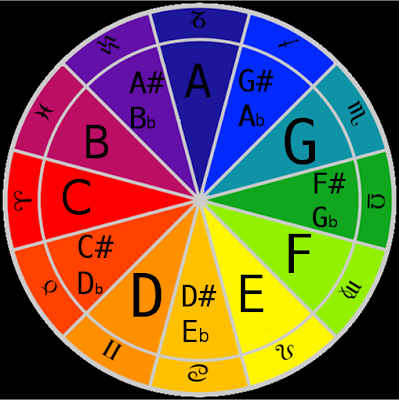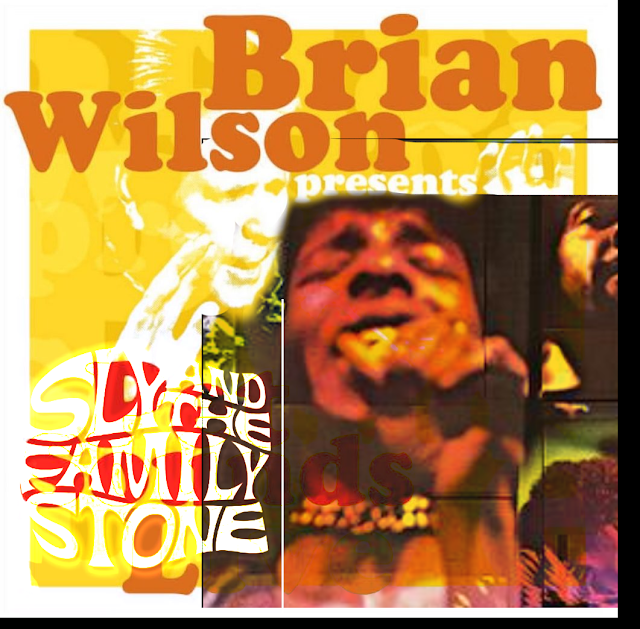Sight, Sound and Sensation.
There are many ways to interface with the Zodiac. Often we think of it as a cerebral framework, and yet there are far more intuitive ways to tune into the subtler energies of the Zodiac. For one, Pythagoras wrote of the colour wheel mapping to the Zodiac, which I learned through RASA. It seems so obvious in retrospect, and yet you'll come across many other colour schemes related to the Zodiac. Almost all systems agree that Aries is Red, and Leo is Yellow. These seem intuitive in a way that is hard to deny (mars being decidedly red, and the Sun being decidedly golden). From here, you can see that the Fire Signs are the primary colours, so it's a small leap to give blue to Sagittarius rounding out that grand trine, blue at the darkest time of the year. If you then map the secondary colours to the Air signs, and fill in the tertiary colours as seen in the wheel above, there is a depth of meaning you can get to in what these signs mean, and how they relate to the seasons. What are your favourite colours? What do they say about how you relate to your own chart? Do you revile from the colour of your Sun, afraid to access your true heart? Do you gravitate towards the colour on your Descendant in an attempt to draw in the type of energy you are destined to desire in this life?
From here, we also have a correspondence to the notes of Western musical theory. Pythagoras had his own system, which I'll bypass for the moment, to discuss what is closer to my heart, as also taught by Robin, the chromatic scale. All twelve notes correspond to all twelve signs. Again, this is obvious. Most systems start the Zodiac at Aries, as the Sun overtakes the Yin energy of winter, moving into the brightness of spring, but this is a somewhat fanciful take on the Zodiac. Life doesn't start in the Spring, nor does a cycle start as the Yang energy overtakes the Yin. All cycles start at the moment of greatest darkness, and must endeavour to access the Yang, as the seed bursts through the soil and asserts itself in the light. Capricorn is the beginning of the Zodiac. So we place A here, and move up in semi-tones through the chromatic scale. Here, we see that Aries gets it's place of prominence by getting attributed C, middle C and all that.... if you play piano you get the element of ease one can attack a keyboard without a plan when you only have to worry about the white keys! How Aries!
Once you start to assimilate yourself to this
system, some profound connections between basic astrological theory and
musical theory come to the fore. Within music theory, the minor third
is the interval which gives a piece of music its “sad” feel... here, the
minor thirds are squares within the zodiac, a difficult aspect. The
Trine within the Zodiac is an element of great ease, within music theory
this becomes the Major Third, an interval which gives music a “happy”
feeling. The opposition within the Zodiac is considered the most
difficult aspect, which becomes the flatted fifth, the much feared and
reviled Devil's Tritone, once banned by the Catholic Church for its baleful
influence upon the audience.
Now that you know
this, if you play an instrument, this is the moment where you need to
HEAR your natal chart. Start with “the big three”. Take the Note which your
Sun is on, the Note your Moon is on, and the note your Ascendant is on,
and play them together as a chord. If you have two or three of these
within the same signs, then add a second and third octave to it. You
can envision the ascendant as the innermost point, (as it spins around
the entire Zodiac every day), give it the highest pitch (faster
frequency), give the Moon the middle pitch, and the Sun the lowest
pitch. Break up the chord and play it as an arpeggio, really grind
those notes together in different ways and you can HEAR how these layers
of your consciousness work together. Now piece the seven classical
planets together. You have a full melody now. Play around with it.
Play it from inner-most planet out to Saturn. Next, break it up into degrees,
regardless of which sign a given planet is in, play the planet with the
lowest degree first, and then the next highest degree, and so on in
order. This is the order which your planets receive transits as any
other planet moves through any given sign. To play and hear this music is a profound ritual of how your life receives energy, treat it as such.
Now add
in the outer-most three planets. When you add in the angles, you're
now guaranteed to have two separate oppositions, or Devil's tritones
within your life's melody. This is the cross of the world. Dealing
with the matters of this Earth are inherently difficult, and they sound
that way. Arrange all these points, (and any more you commonly use) into
a complex melody via the ascending degrees in which they are placed.
Learn it. Play it. Find the rhythm between these notes which feels
natural to you. What does the spacing you play these notes in say about
how you relate to these planets? How will you arrange a chordal
backing to this? You are into some pretty wild Be-Bop domain now!
We can go on, there are stranger and more complex ways of using this
musical system, but let's back out for a moment. If you aren't a
musician, this is still of practical use to you! I hope you stuck
with us to this point. Take your favourite song, you can easily
research online what key signature it is written in. Without getting
even deeper into the entire layout of the song, just think about which
Zodiac sign that key signature belongs to, does it relate to the
intention of the song? How does it colour it? Some musicians go back
to the same keys over and over again more than others. Are they
accentuating elements of their chart they need to gain more experience
using, or are they relying on that which is natural and easy to them. What does the sign of this key of songs you love mean to your chart?
The potential for musical therapy in remediating aspects of your natal chart you struggle with are powerful with this system. Have fun exploring!




Comments
Post a Comment